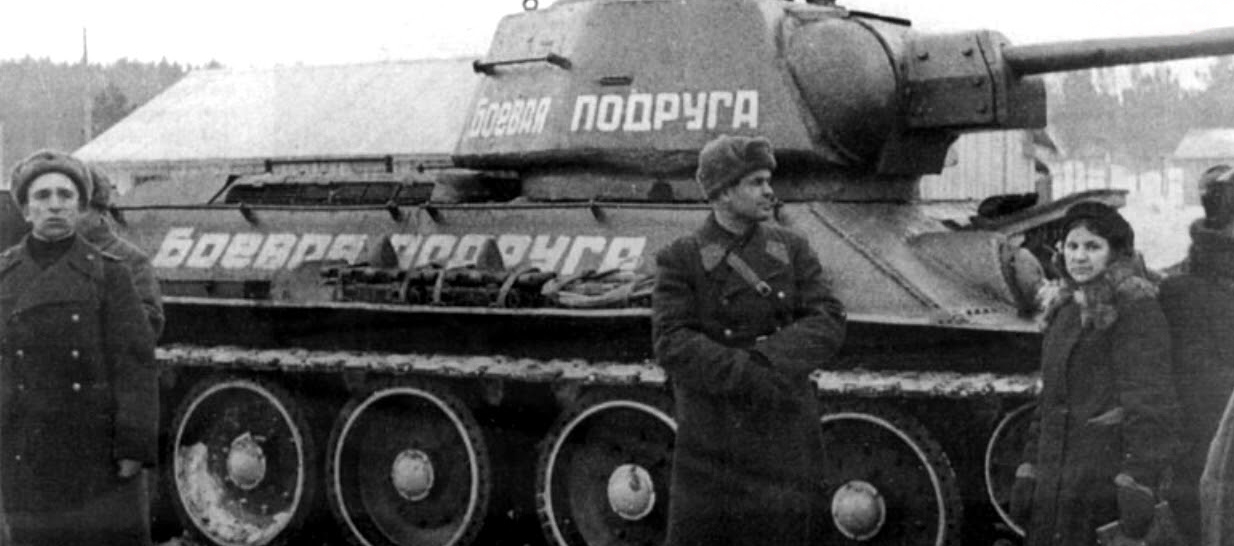
The Fighting Girlfriend : A love story untold.
After her husband was killed fighting in 1941, Oktyabrskaya sold her possessions, donated a tank for the war effort and requested that she be allowed to drive it.
January 30 ,2019
Mariya Vasilyevna Oktyabrskaya was a Soviet tank driver and mechanic who fought on the Eastern Front against Nazi Germany during World War II. When the eastern front of World War II opened, Mariya was evacuated to Tomsk in Siberia. While living in Tomsk, she learned that her husband was killed fighting the forces of Nazi Germany near Kiev in August 1941. The news took two years to reach her. The news angered her greatly, and she became determined to fight the Germans in vengeance for her husband's death. After her husband was killed fighting in 1941, Oktyabrskaya sold her possessions to donate a tank for the war effort, and requested that she be allowed to drive it. She donated and drove a T-34 medium tank, which she named "Fighting Girlfriend". She proved her ability and bravery in battle, and was promoted to the rank of Sergeant. She was killed in battle in 1944, and was posthumously made a Hero of the Soviet Union, the Soviet Union's highest award for bravery during combat. She was the first of the few female tank drivers to be awarded this honor. She sold all of her possessions to donate a tank for the Red Army. She requested the tank to be named "Fighting Girlfriend" and that she be allowed to drive it. The State Defense Committee agreed to this. The tank Mariya donated was a T-34 medium tank.
By this time Oktyabrskaya was 38 years old. She took part in a five-month tank training program immediately after the donation. The five months of training was unusual for tank crews at the time: usually, tank crews were rushed straight to the front line with minimal training. After completing her training, she was posted to the 26th Guards Tank Brigade, part of 2nd Guards Tank Corps, in September 1943 as a driver and mechanic. She named her tank 'Fighting Girlfriend' and emblazoned these words on the turret of the T-34. Many of her fellow tankers saw her as a publicity stunt and a joke, but this attitude changed when Oktyabrskaya began fighting in her first tank battles in Smolensk.
Her first tank battle began on 21 October 1943. Her first battle involved Oktyabrskaya maneuvering her tank in intense fighting; she and her fellow crew members destroyed machine-gun nests and artillery guns. When her tank was hit by gunfire, Oktyabrskaya, disregarding orders, would leap out of her tank and repair the tank, amidst heavy fire. During this feat she was promoted to the rank of Sergeant.A month later, on 17–18 November, the Soviet forces captured the town of Novoye Selo in the region of Vitebsk during a night battle. During this attack, Oktyabrskaya enlarged her reputation as a skilled tank driver. On the 17th, Oktyabrskaya took part in an assault on the German positions near Novoye Selo. However, a German artillery shell exploded against her tank's tracks, halting her advance. Oktyabrskaya and a fellow crewman jumped out to repair the track, while other crew members gave covering fire from the tank's turret. Eventually, they fixed the tank track and her tank rejoined the main unit several days later.
Two months later, on 17 January 1944, Oktyabrskaya fought in another night attack as part of the Leningrad–Novgorod Offensive. The battle would prove to be her last. The attack took place at the village of Shvedy near Vitebsk. During the battle, she drove her T-34 about the German defenses, and destroyed resistance in trenches and machine-gun nests. The tank crew also destroyed a German self-propelled gun. Subsequently, the tank was hit by a German anti-tank shell, again in the tracks, and was immobilized. Oktyabrskaya immediately got out of the tank and began to repair the track, amid fierce small arms and artillery fire. She managed to repair the track, but she was hit in the head by shell fragments and lost consciousness. After the battle she was transported to a Soviet military field hospital at Fastov, near Kiev, where she remained in a coma for two months, before finally dying on 15 March. The following August, Oktyabrskaya was posthumously made a Hero of the Soviet Union in recognition of her bravery in the battles around Vitebsk.